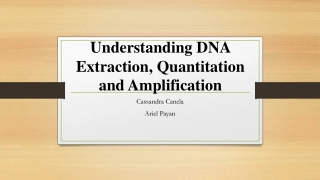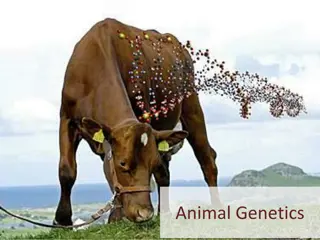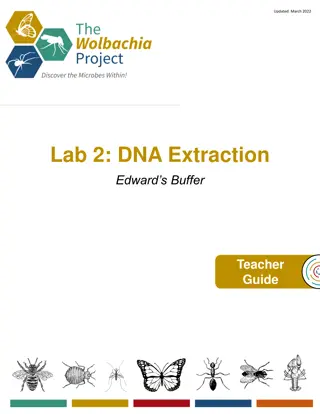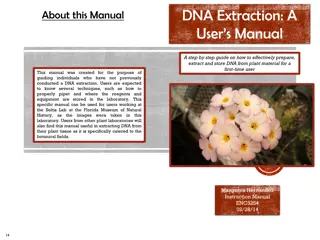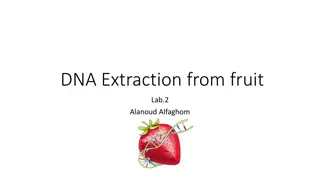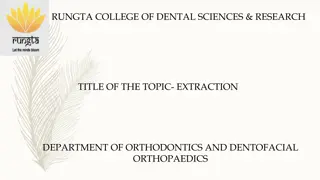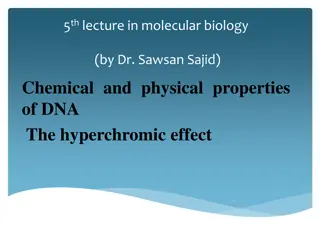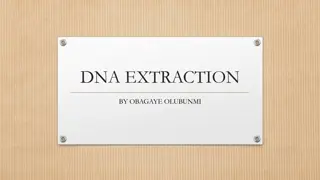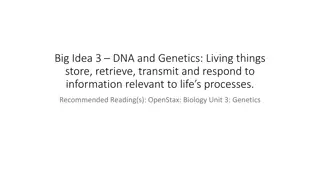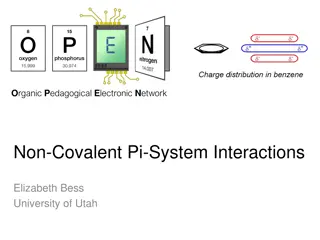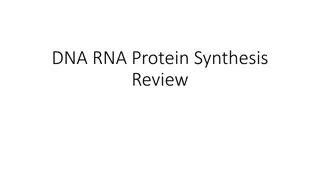Understanding DNA Extraction from Strawberries in Molecular Genetics
In this molecular genetics lesson, students explore DNA extraction from strawberries. The content covers the structure of DNA, nucleotides, and the role of DNA in determining genetic information. Students learn about the components of nucleic acids, DNA functions, and the double helix structure of deoxyribonucleic acid. The lesson also includes a hands-on lab activity for strawberry DNA extraction.
Download Presentation

Please find below an Image/Link to download the presentation.
The content on the website is provided AS IS for your information and personal use only. It may not be sold, licensed, or shared on other websites without obtaining consent from the author. Download presentation by click this link. If you encounter any issues during the download, it is possible that the publisher has removed the file from their server.
E N D
Presentation Transcript
Molecular Genetics Week 7 2015 - 2016
9/28 DNA: The Model of Heredity 11.1 Obj. TSW examine DNA from Strawberries through a process of DNA extraction. P.58 NB 1. What Nucleic Acid is responsible for all of our genetic information, please spell it out. 2. What are the three components (nitrogen bases and backbone) to this Nucleic Acid? 3. Draw the structure of DNA, describe it in words and label the 3 parts. HW Read CH 11 , 1 pg. Notes P. 61 NB http://learn.genetics.utah.edu/
The structure of nucleotides #1. The simple sugar in DNA, called deoxyribose (dee ahk sih RI bos), gives DNA its name deoxyribonucleic acid. The phosphate group is composed of one atom of phosphorus surrounded by four oxygen atoms, it has a negative charge. resources
The structure of nucleotides #2. DNA is a polymer made of repeating subunits called nucleotides. The backbone is made up of the Sugar and Phosphate group. Nitrogenous base Phosphate group Sugar (deoxyribose) Nucleotides have three parts: a simple sugar, a phosphate group, and a nitrogenous base. resources
#2. What are the two functions DNA? Although the environment influences how an organism develops, the genetic information that is held in the molecules of DNA ultimately determines an organism s traits. DNA achieves its control by determining the structure of proteins. resources
#3. Deoxyribonucleic Acid Shape= a Double Helix Backbone = Sugar & Phosphate Nitrogen base Guanine Thymine Adenine Cytosine
Strawberry DNA Extraction Lab p. 43 Write the title in your Notebook 1) Will we extract DNA from the strawberries? If so, what will the DNA look like? Hypothesis: If, then statement (for example. If I crush the strawberries and add the buffer, then I will extract 2 tablespoons of DNA.) Materials: Ziplock bag Strawberries Soap: used to dissolve phospholipid bilayers of the cell membrane Salt: break up protein chains around the DNA Ethanol: DNA is NOT soluble in ethanol (what does this mean?) Funnel Cheese cloth Test tube Stirring rod
Procedure 1. Place one strawberry in the plastic bag. Close the plastic bag. Now, squish the strawberry! (*make sure not to break the bag*) 2. Add 10 mls of buffer solution and mix. 3. Place the funnel in the test tube and place cheesecloth on top of the funnel. 4. Strain strawberry mixture 5. OBSERVE MIXTURE in the test tube. Remove Strawberry mush into the trashcan from the cheesecloth. Rinse the cheese cloth in the sink. 6. Add 5 mls of rubbing alcohol. 7. OBSERVE MIXTURE and record results. 8. Place stir rod into test tube to extract DNA.
Continued DNA Extraction Buffer Contains in 600ml Beaker: 450 mls of water 50 mls of soap 1 tsp salt As you do the lab, make sure you make your observations!
Strawberry DNA Extraction Lab 1. Prediction: What do you THINK we will have to do in order to extract DNA from a strawberry? Write in complete sentences. http://t0.gstatic.com/images?q=tbn:ANd9GcRdV8G8l4nVQjcGpOmA1ENplAOLLH-QsBZO05fyrBby2eLib6a_dA:tasty-dishes.com/data_images/encyclopedia/strawberry/strawberry-03.jpg
Conclusion And Analysis Answers To Precipitate DNA from Solution D Separate components of the cell A Break open the cells C Break up protiens and dissolve cell membranes B
Conclusions! P. 59 Strawberry DNA Extraction AXES Paragraph 1. What did the DNA look like? What is it s shape? 2. How were we able to see it? 3. Why was it essential to add buffer? 4. Why was it essential to add ethanol? 5. What is an example of a Nucleic Acid? 6. Why is DNA important?
The structure of nucleotides A nitrogenous base is a carbon ring structure that contains one or more atoms of nitrogen. In DNA, there are four possible nitrogenous bases: adenine (A), guanine (G), cytosine (C), and thymine (T). Cytosine (C) Guanine (G) Thymine (T) Adenine (A) resources
#3. (DNA)Nitrogen Base Pairing Rules ADENINE = THYMINE CYTOSINE = GUANINE G = ? T = ? A = ? C = ?
DNA/ RNA Beads p. 59NB Backbone= Phosphate & Sugar (Red & White) Nitrogen Bases= Adenine (Blue)=Thymine (Green) Cytosine (Yellow )=-Guanine (Orange) Uracil (Pink) RNA Hydrogen bond (clear barbell) http://learn.genetics.utah.edu/ WS - DNA Model Discussion questions
DNA Model Discussion Questions p. 59NB Please write in complete sentences. 1. What is the general Structure of the DNA molecule? 2. What are the 3 parts of a nucleotide? 3. Name the 2 molecules which alternate to make the sides or backbone of the DNA molecule. 4. Name the 4 nitrogen bases. 5. To which molecules does the nitrogenous base attach? 6. What are the base pairing rule for DNA? 7. If there are three thymine bases on your model, how many adenine bases will there be?
DNA Model Discussion Questions 8. Draw a picture of your DNA. Label the sugar, a phosphate, and all the bases on the left and right side of the molecule you constructed. 9. If you were to open the entire DNA molecule along the hydrogen bonds and attached new bases to the sides you would have two new DNA molecules. Would these 2 DNA strands have the same base pairs? 10. Would the two DNA molecules that resulted from replication be the exact copies of each other? Explain. Why is this important?
9/29 DNA Structure & Function CH. 11.1 Obj: TSW review DNA structure & function. Pg. 60 1. Name two functions of DNA. 2. Draw a nucleotide and label the three components. 3. Use the base pairing rules you learned yesterday to determine the complimentary sequence of this DNA strand: 5 -TACGGTACT-3
Learn.genetics.utah.edu P. 45 NB Write a summary paragraph about DNA. Write 3 5 sentences about the shape of DNA, the nitrogen bases, the bond that holds them together and what a nucleotide is. Build a DNA Molecule Match the nucleotide base pair What bases always pair together? What holds the base pairs together?
Question If there is one strand of DNA with the code: AATCCGGATA What would its complimentary strand (strand across from it) look like?
Answer AATCCGGATA TTAGGCCTAT A always pairs with T C always pairs with G
9/30 DNA Replication DNA Replication 11.1 Obj. TSW demonstrate base pairing rules of DNA Replication by constructing a 2-D model of DNA with paper. P.62 NB 1. What is DNA replication? 2. Why does DNA replicate? 3. Diagram the of DNA being replicated Replication Video HW CH 11 1 page Notes P. 61 NB Show video DNA Replication
#1. Replication of DNA Before a cell can divide by mitosis or meiosis, it must first make a copy of its chromosomes. The DNA in the chromosomes is copied in a process called DNA replication. Without DNA replication, new cells would have only half the DNA of their parents. resources
DNA Replication Replication of DNA Replication resources
DNA Replication DNA replication: the DNA in chromosomes is copied in this process If I say a strand contains: AATTCC on one side, what will the complementary strand be? You can predict what the bases will be on the other side! Part of replication uses this logic. During DNA replication, each strand serves as a pattern, or template, to make a new DNA strand.
#3. Steps of DNA Replication STEP 1. Separation of Strands: When a cell begins to copy DNA, the DNA unwinds, and the hydrogen bonds are broken. This allows the bases of nucleotides to be exposed. Unwinding! Hydrogen bonds broken! (like unzipping!) STEP 2. A new Sugar- Phosphate backbone forms along the new strand forms.
DNA Replication 3 to 5 RULE DNA strands go from 3 to 5 or 5 to 3 - When DNA strands pair, it is opposite STEP 3. Base pairing: Free nucleotides pair with the exposed DNA bases. STEP 4. Two molecules of DNA are Formed; each is half original & Half complementary.
Semi-conservative Replication Half of the DNA is Original the other half is new (Complementary)
DNA Replication Lab Materials: Scissors, tape, DNA template (on white piece of paper), blank white piece of paper, 4 of each nitrogenous bases (each one different color of paper). Procedures: 1. Pair up with a partner 2. Get supplies: 2 Original Strands of DNA backbone (White), & 1 paper of 4 of each of the Nitrogen Bases 3. Base pair the nitrogen bases to the Deoxyribose sugar. 4. Draw your Hydrogen Bonds A=T; C=G 5. Write Original Strand on the two white DNA Backbones. 6. After McAllister reviews your model, she will give you 2 Yellow Backbones that are the complementary strands to base pair your Original strand to. 7. Cut your Original Strand in , and base pair the complementary strand to it. 8. When you have finished your model, answer the questions below in your notebook P.47NB Questions: 1. List the 3 functional groups & the 4 nitrogenous bases found in DNA. 2. List the rules for base pairing in DNA. 3. What are the two main functions of DNA? 4. Draw DNA Replication with two different colors.
DNA Replication Activity Tape your Replicated DNA p.47NB 1. What is Semi Conservative Replication? 2. 3. 4. What are the two main functions of DNA? Why is DNA Replication important? List the 3 functional groups & the 4 nitrogenous bases found in DNA. 5. 6. Draw DNA Replication with two different colors. List the rules for base pairing in DNA. http://library.thinkquest.org/C004535/media/dna_replication.gif File:DNAreplicationModes.png
10/1 Cell Growth & Reproduction: Mitosis CH 8.2 Obj. TSW understand the cell cycle and processes at each stage. P. 64 NB 1. What is mitosis? 2. Draw the Cell Cycle. 3. What is the result of Mitosis?
Problem Solving Lab 8.2 P. 204BB p. 65 NB Read the Observe & Infer section. Read the Solve the Problem. Answer the three Thinking Critically questions p. 65NB 1. Growth 1 phase- Rapid Growth & metabolism of Interphase is the most variable in length. 2. The two types of cells have different functions and one is more complex than the other. 3. The cycle of some types of cells is faster then others because of the complexity of the proteins made by the cell or the need to produce cells due to rapid wear and tear like skin cells compared to muscles cells.
Mitosis Practice p. 67NB Get 2 white boards/ lab station Get 1 Expo marker / 2 students Draw a nucleus and place your replicated chromosomes inside the nucleus. With the yellow and red chromosomes, practice the 4 stages of Mitosis, drawing and erasing the nucleus as the stages dictate. After you show them to us, Then draw the phases of Mitosis on page 67 NB.
Mitosis Rules Mental model of how a cell cycle works that shows an end result of 2 identical cells after Mitosis with the same number of chromosomes. Set up rules for what a cell can and can not do. What steps do they have to go through to create two new identical cells. Result of Mitosis: 2 identical cells with the same # of chromosomes that make tissues, that form organs, that are part of an organ system and make an organism.
10/2 RNA (Ribonucleic Acid) CH 11.2 Obj. TSW compare and contrast the structure and function of DNA and RNA in the Warm Up, and from the video. P. 66 NB 1. Describe how RNA s structure differs from DNA s structure in three ways? 2. Identify and describe the functions of the three types of RNA. What is the main difference between Transcription and DNA Replication? 3. http://www.newbornscreening.info/Pro/Images/cellChromoBase.gif Study for DNA Quiz: CH 11 Tuesday Work on your Cell Lab Final Lab due Friday
Science Article: Endosymbiotic Theory p. 69 NB Read the article quietly. Read the article out loud. Pair up and write the Claim, Evidence and Reasoning Discuss as a class: Endosymbiotic Theory Turn the Paper over and write the AXES Paragraph on Endosymbiotic Theory
#1. RNA RNA like DNA, is a nucleic acid. RNA structure differs from DNA structure in three ways. First, RNA is single stranded it looks like one-half of a zipper whereas DNA is double stranded. resources
#1. Transcription To return to the chapter summary click escape or close this document.
#1. RNA Both DNA and RNA contain four nitrogenous bases, but rather than thymine, RNA contains a similar base called uracil (U). Uracil forms a base pair with adenine in RNA, just as thymine does in DNA. Uracil Hydrogen bonds Adenine resources
#1. Second: Chemical Difference of DNA and RNA Uracil is the Nitrogen base that replaces Thymine To return to the chapter summary click escape or close this document.
#1. RNA Ribose Third: The sugar in RNA is Ribose; DNA s sugar is deoxyribose. resources
#2. RNA Transfer RNA (tRNA) is the supplier. Transfer RNA delivers amino acids to the ribosome to be assembled into a protein. http://t2.gstatic.com/images?q=tbn:ANd9GcQ_Im0qWpp_hJyt2d2BvmZ8-oQzrEWiwkJwK_y-qomkFUQ3-SvQqQ:academic.pgcc.edu/~kroberts/Lecture/Chapter%25207/07-13_tRNA_L.jpg Click image to view movie resources
#2. RNA There are three types of RNA that help build proteins. Messenger RNA (mRNA), brings instructions from DNA in the nucleus to the cell s factory floor, the cytoplasm. On the factory floor, mRNA moves to the assembly line, a ribosome. resources
Protein Synthesis Wednesday!!!!! 1 large bag of M & M s Katelynn 1 large bag of Gummy Bears Yvette 4 bags of Marshmallows-Jon, Alena, Genevieve,Rosabella 1 stick of Butter McAllister 1 box Rice Krispy Cereal - Lilli
Protein Synthesis Wednesday!!!!! Period 3 1 large bag of M & M s William & Sterling 1 large bag of Gummy Bears Willie 4 bags of Marshmallows-Morgan, Dillon, Nisha 1 stick of Butter Angelo 1 box Rice Krispy Cereal - Denis
DNA Replication Practice p. 69NB Directions: Using one half of the a DNA helix, show what the correct pairing would be, skip lines. 1. ATT CGT TAC CAC CTC 2. TAT TAG GCA ATA TTC 3. GTG TGA TTA ATA GCC 4. CTA AAG GAA TAG GAT 5. GAT GAA TAC CCA CGA 6. TAA TAT GCA CAT TAC 7. GAA CCT TAC GGG GTG 8. TAT AAC CAG GAG TTT 9. ATC CGT AGT GTA AAT 10.GGA TTA CCC TTA CCA
DNA Quiz 1 piece of Binder Paper & pencil or pen. Write your name on the top right hand side. 1. What is the name of the molecule that holds our genetic information? 2. What is the shape of that molecule? 3. Where is that molecule located in the cell? 4. What are the 4 Nitrogen Bases that code for Amino Acids? 5. Write how the Nitrogen base pair together. 6. What is the bond that holds the nitrogen bases together? 7. Draw & Write the three parts of a nucleotide. 8. What is DNA Replication? 9. What are the two functions of DNA? 10. How is RNA different from DNA?
Genes Expression = Proteins You learned earlier that proteins are polymers of amino acids. The sequence of nucleotides in each gene contains information for assembling the string of amino acids that make up a single protein. resources
#2. RNA The ribosome, made of ribosomal RNA (rRNA), binds to the mRNA and uses the instructions to assemble the amino acids in the correct order. resources
What Process is this? What are the steps? What is the name for this particular type of process? To return to the chapter summary click escape or close this document.


